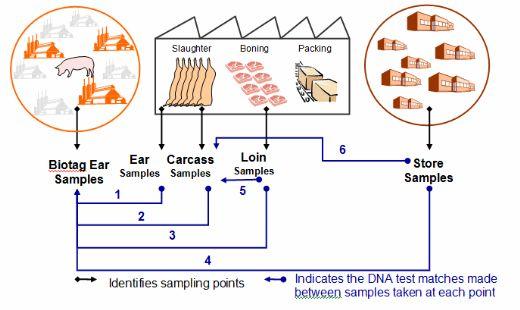DNA Technology and Traceability in Pig production
A DNA technology trial to demonstrate the identity preservation and traceability of pigs from farm to retail
Published: January 14, 2011
By: Dr. Dan Hurnik and Kimberley MacDonald
DNA analysis has evolved in roles such as forensic medicine, and paternity genetics in the past years and more recently its capabilities have been challenged as a traceback mechanism within the meat production industry. In Ireland IdentiGEN's DNA TraceBackTM technology was able to detect wrongly-advertised South American beef product as Irish beef, and some non-beef products as beef 1. The European Union enacted legislation in 2000 as an attempt to restore consumer confidence following the devastating BSE crisis of 1996, and this legislation recognized the importance of linking the source animal and farm to retail products in an effort to create a safer consumer perception2. Presently, North America lacks a mandatory traceability program to follow product post slaughter into the retail sector. Such a program holds many important implications and benefits that can be enhanced by regulatory and field veterinarians. Firstly, there is a direct increase in food safety control, secondly it enables a specific "brand" of product to be marketed3 which ensures brand integrity. Furthermore, implementation of disease zones3 ie:FMD allows for improved monitoring of the movement of these animals hence increasing the safety margin for other herds and production systems within the area at the minimum. Regulatory drug residue control can be amplified, as well as allowing a faster and more effective recall for contaminated products to occur3. Improvements in areas such as increasing protection against bio-terrorism and an overall quality control can also be enforced3. Using advances in modern biotechnology, such traceability systems are possible and would go far to further enhance public confidence.
DNA technology is able to identify the live animal; the fresh-killed carcass; cutting room products as well as retail products-either fresh or cooked quickly and accurately 3,4,5. This technology is based on the polymorphism DNA phenomena5. Most DNA makeup is identical within a species; however, there are inherited regions of DNA that can vary from animal to animal called polymorphisms6. Generally, the key to DNA traceability is a single nucleotide polymorphism (SNP), which is a single base unit change in a DNA sequence3. Approximately 200-300 SNPs are required for analysis3 and can be extracted from less than 1g of animal tissue4. The animal tissue sample must be obtained via a specified protocol as determined by IdentiGEN and obtained from a consistent tissue sample site as determined by the product to be traced-back in this study4 .
Using branded pork products produced and slaughtered on Prince Edward Island, the application of DNA TraceBackTM technology was evaluated by the identity of livestock throughout the production chain, from farm to market5.
DNA traceability in hogs was studied using a 6 week pilot project that included control points throughout the food chain5. These controls began with on farm live samples using BiotagsTM, they were followed with post slaughter ear samples, carcass samples, cutting room loin samples and finally market samples obtained at the retail level. The first control point, ear sampling, verified traceability of the slaughtered animal back to the farm. Subsequent sampling of the carcass enabled a second reference point for previously tagged animals using the BiotagTM as well as a primary DNA reference sample archive for all carcasses contributing to the program5.
Materials and methods
Implementation of a 3 day training program for participants in the application of eartags, sampling in the abattoir and retail outlets as well as collation of animal ID with the samples initiated this pilot study. Traceability began at the abbatoir sampling fresh carcasses using IdentiGEN's carcass sampling kit. Samples were separated and identified according to the farm carcass tattoo and forwarded to the Atlantic Veterinary College for freezing and archiving. On farm sampling of 166 market hogs from the 3 participating farms ensued 2 weeks later via collection of IdentiGEN DNA sampling BiotagsTM. The origin of each farm was recorded and samples were again forwarded directly to the Atlantic Veterinary College and frozen for storage and archiving. A subset of the 146 ear samples taken at slaughter were analyzed and compared to the original BiotagTM samples. Twenty cutting room loin samples were obtained as a second verification sample and subsequently labeled via the slaughter and sampling date. Again these additional samples were sent to the Atlantic Veterinary College for frozen storage and archiving. The last verification samples were obtained in 10 retail outlets on Prince Edward Island over a 15-day period. This process began a few days after the last abbatoir verification sample had been taken, and these samples were identified with the date and location of sampling as well as the product sampled. The DNA analysis of all project samples was performed at IdentiGEN's laboratory in Dublin, Ireland; where DNA was extracted from the air shipped iced samples using customized protocols and a DNA profile was generated.
Results and discussion
The four sources of the verification samples:
1. Ear samples (April 20): Twenty ears sampled from the slaughter-house kill floor were selected for cross matching (Control 1, Annex 1). Two of these samples were illegible due to tag melting during processing. DNA was extracted and analyzed from the twenty ear samples and were successfully identified to match the appropriate BiotagTM. The 2 unidentifiable samples were unable to be matched to the tag number, but as expected all ear tissue matched and thus identified the pig.
2. Carcass samples (April 9- May 14): The effectiveness of 300 carcasses sampled for referencing is reported in Table 1.Verification analysis of the carcass samples used 20 animals slaughter on April 30. DNA was extracted from the 20 carcass samples and was correctly identified as being derived from the April 30 slaughter samples (Control 2, Annex1). Concurrently 22 BiotagTM samples (obtained pre-slaughter) were analyzed and matched 100% correctly to the individual pre-chilled carcass.
3. Cutting room, loin sample (May 1): Twenty loin samples were obtained in the cutting room from animals slaughtered on April 30 (Control 3, Annex1). The identity of 19/20 of these loin samples were confirmed with matching of the appropriate Identigen BiotagTM samples obtained from the on farm live hog. The failure to match the last cutting room loin sample may be due to the incorrect selection of carcass for boning in the program range products or carry over between batches in the cutting room.
A second batch of 20 hogs were slaughtered on May 6 and sampled in the cutting room on May 7. All 20 of these cutting room loin samples matched to their farm of origin as well as carcasses supplied to the program's pork products. These hogs had not been BiotaggedTM at the animal level therefore the opportunity to traceback to the farm of origin was not possible (Control 5, Annex1). Table 2 reflects the efficacy of the loin sample matching.
4. Market sample: Program pork products were purchased from a variety of retail markets across Prince Edward Island resulting in 33 retail samples obtained, including 1 spiked sample. Using DNA analysis 31 samples were traced back to source carcasses with >99.9% confidence; furthermore 26/31 were traced back to the individual hog on the farm via their BiotagTM (Control 4, Annex 1). The 5 samples that were not matched to a BiotagTM, were traced back to farms on the branded pork program, but did not participate in the BiotagTM pilot (Contol 6, Annex 1). Two retail samples were not able to be identified to their source carcass with an acceptable level of confidence, which is 99.9% (Table 3) to declare a reliable DNA match. This failure to match was due to poor sample quality observed with sample 7 that matched carcass no.77 with a 99% confidence level. The second sample that did not match any animal in the project was indeed the spiked sample obtained from a different pork product range. DNA analysis identified the spiked sample, as it did not match any carcass or BiotagTM in the project.
Implications of DNA traceback technology success in this project:
- the BiotagTM has proven reliable with >99.9% confidence
- the primal cut samples obtained in the cutting room clearly establishes the ability of DNA traceback technology to identify the source animal of cut pork products through the use of the BiotagTM, or to farm of origin using the carcass tattoo
- in the cutting room where the farm and animal identity is lost, DNA technology can identify the source carcass
- success of retail traceback was also demonstrated to the animal and farm of origin
- DNA technology correctly identified a loin in the branded production line that originated from an unbranded carcass
- without DNA technology there is no way to identify this product
Conclusion
In conclusion, there is definite potential for DNA TraceBackTM technology in tracking pork cuts from supermarket to the source animal and farm for livestock. This technology allows for an immediate industry response to any level of potential complication in the market place, slaughter plant, or farm. It also allows regulatory veterinarians to play a more intricately targeted role thus increasing the safety level of public protection against disease and bio-terrorism with minimal financial implications. Currently, there is no mandatory implemented safety traceability program post-slaughter and with the demonstrated efficacy of the DNA traceback process (with its calculated percentages clearly indicating the success in correlating the meat product sampled at the retail level to both source farm and animal) there is definitely a sufficient rationale to implement this safety feature in the current market environment.
Acknowledgements
Canadian Food Inspection Agency, PEI Agriculture and Food Trust, Atlantic Veterinary College, IdentiGEN Institute of Technology, and Daniel Hurnik
References
1. Logue P. Irish consumers cheated by beef labeling. http://www.ireland.com. Accessed September 24, 2003.
2.TraceBackTM. Background Information. http://www.identigen.com/html2/MainTBBGInfo.htm. Accessed October 27, 2003.
3. Webb J. DNA tracking from meat to farm origin. Proceedings of, Agriculture and Agri-food Canada traceability rendez-vous. March, 2003.
4. TraceBackTM. Sampling Information. http://www.identigen.com/html2/MainTBSamp.htm. Accessed October 27, 2003.
5. Morris S, Hurnik D, Jenkins P, Scott C, Loftus R. Pilot study to determine the suitability of DNA traceability technology as a CFIA operational tool for genetically modified livestock to ensure identity preservation. 2003.
6. Blackett. The biology project. http://www.biology.arizona.edu/human_bio/activities/blackett2/str_description.html. Accessed September 11, 2003.
Table 1: Effectiveness of carcass reference sampling


Table 2: Effectiveness of loin sample verification sampling


Table 3: Summary of unmatched retail samples

ANNEX 1
Sampling Flow Chart

Sampling Flow Chart

Sampling points along the supply chain are indicated by the black lines. Levels of traceability were checked between different sampling points as indicated by the numbers 1 - 6.
Related topics
Authors:
University of Prince Edward Island
Recommend
Comment
Share

Would you like to discuss another topic? Create a new post to engage with experts in the community.






